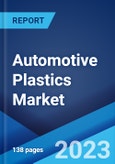Automotive plastics include polypropylene (PP), polyurethane (PU), polyvinyl chloride (PVC), acrylonitrile butadiene styrene (ABS), nylon, polyethylene (PE), polyoxymethylene (POM) and polycarbonate (PC). These plastics assist in extending the life of automobiles, increasing design flexibility, reducing manufacturing costs and easing integration of components. Besides this, they also help reduce the weight of vehicles by replacing heavy materials, such as metal and glass, to save energy and improve fuel efficiency.
Automotive Plastics Market Trends:
There is currently a rise in the sales of electric and hybrid vehicles (EVs/HVs) around the world. This represents one of the key factors propelling the growth of the market. Moreover, automotive plastics find applications in the production of fuel tanks, carpet fibers, wheel covers, suspension bushings, dashboards, headlamp lenses, truck bed liners, mud flaps, bumpers, and gears. In addition, there is an increase in the use of synthetic coatings on metal surfaces to minimize the risk of corrosion caused by salt damage, high heat and water exposure. Besides this, nylon is utilized for manufacturing seat belts and airbags on account of its tear-resistant properties. This, along with the escalating demand for lightweight and affordable vehicles, is positively influencing the market. Apart from this, leading players are relying on bio-based plastics and polymers instead of fossil-based plastics to reduce their carbon footprint and promote sustainability. Furthermore, they are using recycled plastics for manufacturing seat cushions, replacement bumpers, splash guards, and wheel liners. This, coupled with the burgeoning plastics industry, is augmenting the overall sales and profitability. Other factors facilitating the growth of the market include technological advancements and extensive research and development (R&D) activities financed by automobile manufacturers.Key Market Segmentation:
The report provides an analysis of the key trends in each sub-segment of the global automotive plastics market report, along with forecasts at the global, regional and country level from 2024-2032. Our report has categorized the market based on vehicle type, material, and application.Breakup by Vehicle Type:
Conventional and Traditional VehiclesElectric Vehicles
Breakup by Material:
Polyethylene (PE)Polypropylene (PP)
Polyvinyl Chloride (PVC)
Acrylonitrile Butadiene Styrene (ABS)
Polyurethane (PU)
Polymethyl Methacrylate (PMMA)
Polycarbonate (PC)
Polyamide
Others
Breakup by Application:
PowertrainElectrical Components
Interior Furnishings
Exterior Furnishings
Under the Hood
Chassis
Breakup by Region:
North AmericaUnited States
Canada
Asia-Pacific
China
Japan
India
South Korea
Australia
Indonesia
Others
Europe
Germany
France
United Kingdom
Italy
Spain
Russia
Others
Latin America
Brazil
Mexico
Others
Middle East and Africa
Competitive Landscape:
The competitive landscape of the industry has also been examined along with the profiles of the key players being Asahi Kasei Corporation, BASF SE, Borealis AG, Covestro AG, Dow Inc., Koninklijke DSM N.V., Lanxess AG, Lear Corporation, LyondellBasell Industries N.V., Saudi Basic Industries Corporation, Solvay S.A and Teijin Limited.Key Questions Answered in This Report
1. What was the size of the global automotive plastics market in 2023?2. What is the expected growth rate of the global automotive plastics market during 2024-2032?
3. What are the key factors driving the global automotive plastics market?
4. What has been the impact of COVID-19 on the global automotive plastics market?
5. What is the breakup of the global automotive plastics market based on the vehicle type?
6. What is the breakup of the global automotive plastics market based on the material?
7. What is the breakup of the global automotive plastics market based on the application?
8. What are the key regions in the global automotive plastics market?
9. Who are the key players/companies in the global automotive plastics market?
Table of Contents
Companies Mentioned
- Asahi Kasei Corporation
- BASF SE
- Borealis AG
- Covestro AG
- Dow Inc.
- Koninklijke DSM N.V.
- Lanxess AG
- Lear Corporation
- LyondellBasell Industries N.V.
- Saudi Basic Industries Corporation
- Solvay S.A
- Teijin Limited
Methodology

LOADING...
Table Information
| Report Attribute | Details |
|---|---|
| No. of Pages | 135 |
| Published | July 2024 |
| Forecast Period | 2023 - 2032 |
| Estimated Market Value ( USD | $ 42.4 Billion |
| Forecasted Market Value ( USD | $ 60.7 Billion |
| Compound Annual Growth Rate | 4.1% |
| Regions Covered | Global |
| No. of Companies Mentioned | 12 |









